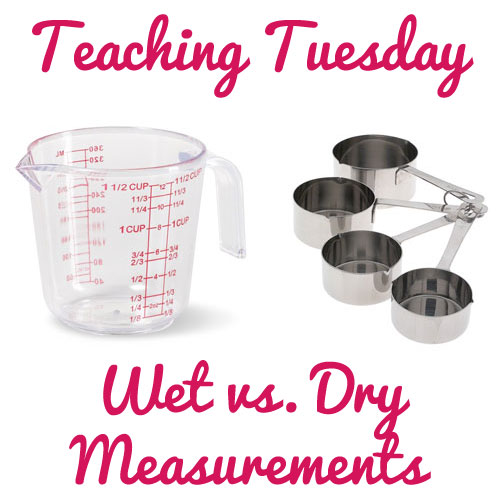After last week's topic on measuring conversions, today's Teaching Tuesday is dedicated to wet and dry measurements.
In just a few minutes you'll learn the difference between wet and dry ingredients, which measuring cup to use, and how to measure properly.

Dry Ingredients
When measuring dry ingredients, you want to use individual measuring cups (like the silver ones in the picture above) or measuring spoons to ensure an accurate reading. My "baker" friends weigh their flour, which is even more accurate than measuring. I'm too lazy to do this, but if you're a little more hardcore than me: 1 cup of flour should weigh 4.5 ounce or 128 grams.
Always use the spoon & level method for measuring flour.This same rule can also be applied to other dry ingredients, but there are a couple of exceptions (I'll get to that in a minute).
Do not scoop the flour out of the bag with your measuring cup. Spoon flour from the bag lightly into the measuring cup. Do not "pack" the flour. Also avoid "tapping" the measuring cup (this causes flour to settle and become more dense). Lightly shake off the excess or use a knife to gently level it off. (For more tips, watch my video on how to properly measure flour.)
I also apply this rule to instant oats, but with rolled oats I "cheat" and scoop with my measuring cup. 1 cup of rolled oats should weigh 3 ounces or 85 grams.
With sugar (i.e., raw sugar or brown sugar), you can scoop it with the measuring cup, unless you want to scale back on how much sugar you're using, then you can use the spoon method. In most recipes, the sugar should be "packed tight" and leveled off, unless directed otherwise. I tend to scoop it lightly and I never pack it down tightly.
Generally, bakers consider "sugar" (as in dry sweetener) a "wet" ingredient, but I don't. I always mix it with my other "dry" ingredients. If my sweetener is a liquid, however, such as maple syrup, then I hold off and add it with the other wet stuff.
Powdered sugar is the exception — you want to sift that, if you can, to prevent lumps.
Liquids
Liquids (such as non-dairy milk) should be at eye level in a liquid measuring cup (like the one above, on the left). When checking to see if the ingredient is at the right level, make sure the measuring cup is on a flat surface. Holding it up to your face may give you an inaccurate reading.
I'll admit, I've used my dry measuring cups to measure liquid and it's usually not a big deal. I filled my plastic 1 cup with water, poured it into my liquid measuring cup - the same! You won't get the same results with dry ingredients though.
Rice, Chopped Nuts, Chips, etc
Like dry ingredients, "bulky" ingredients should be spooned into a measuring cup. Use your fingers to level the contents, but don't pack it down.













